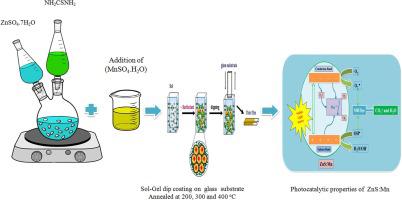当前位置:
X-MOL 学术
›
Inorg. Chem. Commun.
›
论文详情
Our official English website, www.x-mol.net, welcomes your
feedback! (Note: you will need to create a separate account there.)
Effect of annealing temperature and Mn doping on the structural and optical properties of ZnS thin films for enhanced photocatalytic degradation under visible light irradiation
Inorganic Chemistry Communications ( IF 4.4 ) Pub Date : 2020-09-01 , DOI: 10.1016/j.inoche.2020.108068 S. Kannan , N.P. Subiramaniyam , M. Sathishkumar
Inorganic Chemistry Communications ( IF 4.4 ) Pub Date : 2020-09-01 , DOI: 10.1016/j.inoche.2020.108068 S. Kannan , N.P. Subiramaniyam , M. Sathishkumar

|
Abstract Herein we report a facile and low cost Sol-Gel method was adapted to design and fabricate highly efficient ZnS photocatalyst. The zinc sulfide (ZnS) thin films have been prepared at different annealing temperatures (200, 300 and 400 °C) and annealing temperatures 400 °C was optimized for Manganese (Mn) doped ZnS (Zn1-x Mnx S) (10 wt%) thin films. The effect of annealing temperature and Mn doping on the structural, optical and photocatalytic properties of ZnS thin films were investigated in detail by using XRD, FESEM, EDS, UV–Vis., PL, XPS and N2 adsorption-desorption analysis. XRD pattern exhibited hexagonal crystal structure for prepared samples and average particle size was increased from 25 to 47 nm with increasing annealing temperature and Mn doping. FESEM images revealed that nanoflake like morphology for annealed samples further it’s found to disappear for Mn doped ZnS samples. The presence Mn2+ ions into ZnS lattice was found from EDS and XPS analysis. Optical properties was analyzed by using UV–Vis. and PL studies and it’s found photogenerated recombination process and surface related defects with considerable red shift within the absorption edge and significant narrowing the band gap energy of undoped ZnS by increased annealing temperature with Mn doping. The large surface area with mesopores nature and tuning the optical property in the visible light region could be improve the rapid photo degradation efficiency of methylene blue dye (MB) under stimulated visible light enlightenment. The ZnS:Mn thin films annealed at 400 °C catalyst showed excellent photodegradation efficiency (99%), good stability with better first order kinetic and easy reusability towards MB dye, furthermore the effect of annealing temperature and Mn doping for the enhanced photo catalytic mechanisms by visible light was also discussed.
中文翻译:

退火温度和Mn掺杂对可见光下增强光催化降解ZnS薄膜结构和光学性能的影响
摘要在此我们报告了一种简便且低成本的溶胶-凝胶方法,用于设计和制造高效的 ZnS 光催化剂。在不同的退火温度(200、300 和 400 °C)下制备了硫化锌(ZnS)薄膜,并且针对锰(Mn)掺杂的 ZnS(Zn1-x Mnx S)(10 wt%)优化了 400 °C 的退火温度。 ) 薄膜。通过XRD、FESEM、EDS、UV-Vis、PL、XPS和N2吸附-解吸分析,详细研究了退火温度和Mn掺杂对ZnS薄膜结构、光学和光催化性能的影响。XRD图谱显示出制备样品的六方晶体结构,随着退火温度和Mn掺杂的增加,平均粒径从25纳米增加到47纳米。FESEM 图像显示,退火样品的纳米薄片状形态进一步被发现对于 Mn 掺杂的 ZnS 样品消失。从 EDS 和 XPS 分析中发现 Mn2+ 离子进入 ZnS 晶格。通过使用紫外-可见光分析光学特性。和 PL 研究发现光生复合过程和表面相关缺陷在吸收边内具有相当大的红移,并且通过提高退火温度和 Mn 掺杂显着缩小了未掺杂 ZnS 的带隙能量。具有介孔性质的大表面积和在可见光区域调整光学性质可以提高亚甲基蓝染料(MB)在受激可见光照射下的快速光降解效率。在 400 °C 下退火的 ZnS:Mn 薄膜催化剂表现出优异的光降解效率(99%),
更新日期:2020-09-01
中文翻译:

退火温度和Mn掺杂对可见光下增强光催化降解ZnS薄膜结构和光学性能的影响
摘要在此我们报告了一种简便且低成本的溶胶-凝胶方法,用于设计和制造高效的 ZnS 光催化剂。在不同的退火温度(200、300 和 400 °C)下制备了硫化锌(ZnS)薄膜,并且针对锰(Mn)掺杂的 ZnS(Zn1-x Mnx S)(10 wt%)优化了 400 °C 的退火温度。 ) 薄膜。通过XRD、FESEM、EDS、UV-Vis、PL、XPS和N2吸附-解吸分析,详细研究了退火温度和Mn掺杂对ZnS薄膜结构、光学和光催化性能的影响。XRD图谱显示出制备样品的六方晶体结构,随着退火温度和Mn掺杂的增加,平均粒径从25纳米增加到47纳米。FESEM 图像显示,退火样品的纳米薄片状形态进一步被发现对于 Mn 掺杂的 ZnS 样品消失。从 EDS 和 XPS 分析中发现 Mn2+ 离子进入 ZnS 晶格。通过使用紫外-可见光分析光学特性。和 PL 研究发现光生复合过程和表面相关缺陷在吸收边内具有相当大的红移,并且通过提高退火温度和 Mn 掺杂显着缩小了未掺杂 ZnS 的带隙能量。具有介孔性质的大表面积和在可见光区域调整光学性质可以提高亚甲基蓝染料(MB)在受激可见光照射下的快速光降解效率。在 400 °C 下退火的 ZnS:Mn 薄膜催化剂表现出优异的光降解效率(99%),









































 京公网安备 11010802027423号
京公网安备 11010802027423号